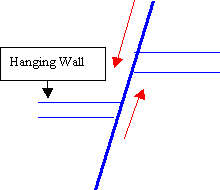

Geological Faults
A geological Fault is a surface embedded in the earth, vertically or inclined at an angle, along which differential movement has taken place, so that one side of the earth has moved relative to the other.
 |
 |
A fault is a tectonic feature, a surface embedded in the ground, along
which differential slippage of adjacent blocks of the Earth’s material has
occurred parallel to the fault. Depending on the dominance of a particular
component of the movement faults are placed in the strike-slip and dip-slip
fault categories. In strike slip movement of a fault one block moves relative to
the other horizontally, while the dip-slip movement occurs in the vertical
direction. Generally, both components of movement are present on a fault. The
fault surface is not, often, in the vertical direction, but is inclined to it at
a certain angle. In dip-slip faults this creates a difference in nature of the
fault movement depending on which side of the fault goes up (up thrown block)
and which side goes down (down thrown block).
|
|
|
Normal Fault Reverse Fault
Movements
in Dip-slip Faults
A
fault with a major dip slip component in which the hanging wall (the block
resting above the fault surface) has moved downwards is called a normal
fault. If the hanging wall has moved up the fault becomes a reverse
fault. A look at the above figures will show that normal faulting is
characterized by tension along the surface of a normal fault, whereas a reverse
fault indicates compression (this can be easily seen by resolving the motion
into two mutually perpendicular directions). There are several other types of
faults, but a large portion of the faults found on the Earth’s surface is
covered under the categories of strike and dip-slip faults. Apart from the
geometrical properties, faults have also been categorized on the basis of their
movement status (history of fault movement). A fault that has been producing
earthquakes in recent times is called an active
fault. A fault that has a significant potential of relative displacement at
or near the ground surface has been called a capable fault. This terminology has been widely used in earthquake
engineering. Any fault, that has exhibited one or more of the following
properties, is considered a capable fault.
1. Movement at or near the Earth’s surface within the past 35,000 years,
or movements of recurring nature within the past 500,000 years.
2. A
structural relationship to a capable fault, such that movement on one could
accompany movement on the another.
The nature of fault movement and the various fault parameters, e.g. length, width, vertical extent (or depth), rate of movement causing energy accumulation and release, shear resistance along the fault surface, amount of possible sudden displacement etc. together determine the seismic risk associated with a fault.
This page was updated on 12 Jan 2011